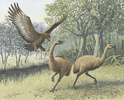Dinornithidae
Moa
Joseph W. Brown


This tree diagram shows the relationships between several groups of organisms.
The root of the current tree connects the organisms featured in this tree to their containing group and the rest of the Tree of Life. The basal branching point in the tree represents the ancestor of the other groups in the tree. This ancestor diversified over time into several descendent subgroups, which are represented as internal nodes and terminal taxa to the right.

You can click on the root to travel down the Tree of Life all the way to the root of all Life, and you can click on the names of descendent subgroups to travel up the Tree of Life all the way to individual species.
For more information on ToL tree formatting, please see Interpreting the Tree or Classification. To learn more about phylogenetic trees, please visit our Phylogenetic Biology pages.
close boxReferences
Alexander, R. M. 1983. Allometry of the leg bones of moas (Dinornithes) and other birds. Journal of Zoology, London 200: 215-231.
Amadon, D. 1947. An estimated weight of the largest known bird. Condor 49: 159-164.
Anderson, A. 1983a. When all the moa-ovens grew cold. Nine centuries of changing fortune for the southern maori. Otago Heritage Books, Dunedin.
Anderson, A. 1983b. Habitat preferences of moa in central Otago, A. D. 1000-1500, according to paleobotanical and archaeological evidence. Journal of the Royal Society of New Zealand 12: 321-336.
Anderson, A. 1984. The extinction of moa in southern New Zealand. Pp 728-740 in Martin, P. S., and R. G. Klein (eds.), Quaternary Extinctions. A Prehistoric Revolution. University of Arizona Press, Tucson.
Anderson, A. J. 1989. Prodigious Birds: Moas and Moa-Hunting in Prehistoric New Zealand. Cambridge University Press, Cambridge.
Archey, G. 1941. The moa: a study of the Dinornithiformes. Bulletin of the Auckland Institute and Museum 1.
Atkinson, I. A. E., and R. M. Greenwood. 1989. Relationships between moas and plants. New Zealand Journal of Ecology 12: 67-96.
Baker, A. J., L. J. Huyen, O. Haddrath, C. D. Millar, and D. M. Lambert. 2005. Reconstructing the tempo and mode of evolution in an extinct clade of birds with ancient DNA: the giant moas of New Zealand. Proceedings of the national Academy of Sciences of the USA 102: 8257-8262.
Brewster, B. 1986. Moa's ark - the natural world of the moa. Forest and Bird 17: 25-28.
Buick, T. L. 1931. The Mystery of the Moa. Thomas Avery, New Plymouth.
Bunce, M., T. H. Worthy, T. Ford, W. Hoppitt, E. Willerslev, A. Drummond, and A. C. Cooper. 2003. Extreme reversed sexual size dimorphism in the extinct New Zealand moa Dinornis. Nature 425: 172–175.
Burrows, C. J. 1980. Some empirical information concerning the diet of moas. New Zealand Journal of Ecology 3: 125-130.
Burrows, C. J., B. McCulloch, and M. M. Trotter. 1981. The diet of moas based on gizzard contents samples from Pyramid Valley, North Canterbury, and Scaifes Lagoon, Lake Wanaka, Otago. Records of the Canterbury Museum 9: 309-336.
Caughley, G. 1977. The taxonomy of moas. Tuatara 23: 20-25.
Caughley, G. 1989. New Zealand plant-herbivore systems: past and present. New Zealand Journal of Ecology 12: 3-10.
Cooper, A., C. Lalueza-Fox, S. Anderson, A. Rambaut, J. Austin, and R. Ward. 2001. Complete mitochondrial genome sequences of two extinct moas clarify ratite evolution. Nature 409: 704-707.
Cooper, A., C. Mourer-Chauviré, G. K. Chambers, A. von Haeseler, A. C. Wilson, and S. Pääbo. 1992. Independent origins of New Zealand moas and kiwis. Proceedings of the national Academy of Sciences of the USA 89: 8741-8744.
Cooper, A., I. A. E. Atkinson, W. G. Lee, and T. H. Worthy. 1993. Evolution of the moa and their effect on the New Zealand flora. Trends in Ecology and Evolution 8: 433-437.
Cracraft, J. 1974. Phylogeny and evolution of the ratite birds. Ibis 116: 494-521.
Cracraft, J. 1976a. The species of moa (Aves: Dinornithidae). Smithsonian Contributions to Paleobiology 27: 189-205.
Cracraft, J. 1976b. The hindlimb elements of the moas (Aves, Dinornithidae): a multivariate assessment of size and shape. Journal of Morphology 150: 495-526.
Cracraft, J. 1980. Moas and Maori. Natural History 89: 28-36.
Davies, S. J. J. F. 2002. Ratites and Tinamous. Oxford University Press, New York.
Diamond, J. M. 1990. Biological effects of ghosts. Nature 345: 769-770.
Duff, R. 1977. The Moa-hunter period of Maori Culture. Government Printer, Wellington.
Falla, R. A. 1962. The moa, zoological and archaeological. New Zealand Archaeological Association Newsletter 5: 189-191.
Fleming, C. A. 1962. The extinction of moas and other animals during the Holocene period. Notornis 10: 113-117.
Fleming, C. A. 1969. Rats and moa extinction. Notornis 16: 210-211.
Greenwood, R. M., and I. A. E. Atkinson. 1977. Evolution of divaricating plants in New Zealand in relation to moa browsing. Proceedings og the New Zealand Ecological Society 24: 21-33.
Hamel, G. E. 1979. The breeding ecology of moas. Pp 61-66 in Anderson, A. (ed.), Birds of a Feather. New Zealand Archaeological Association Monograph 11.
Hamilton, J. W. 1975. Notes on the Maori traditions of the moa. Transaction of the New Zealand Institute 7: 121-122.
Harrath, O., and A. J. Baker. 2001. Complete mitochondrial genome sequences of extinct birds: ratite phylogenetics and the vicariance biogeography hypothesis. Proceedings of the Royal Society of London Biological Sciences 268: 939-945.
Holdaway, R. N., and C. Jacomb. Rapid extinction of the moas (Aves: Dinornithiformes): model, test, and implications. Science 287: 2250-2254.
Horn, P. L. 1989. Moa tracks: an unrecognised legacy from an extinct bird? New Zealand Journal of Ecology 12: 45-50.
Huyen, L., C. D. Millar, R. P. Scofield, and D. M. Lambert. 2003. Nuclear DNA sequences detect species limits in ancient moa. Nature 425: 175-178.
Lowry, J. B. 1980. Evolution of divaricating plants in New Zealand in relation to moa browsing. New Zealand Journal of Ecology 3: 165.
McGlone, M. S., and B. D. Clarkson. 1993. Ghost stories: moa, plant defences and evolution in New Zealand. Tuatara 32:1-21.
Millener, P. R. 1982. And then there were twelve: the taxonomic status of Anomalopteryx oweni (Aves: Dinornithidae). Notornis 29: 165-170.
Oliver, W. R. B. 1949. The moas of New Zealand and Australia. Dominion Museum Bulletin No. 15: 1-206.
Roberts, W. H. S. 1875. Notes on the moa. Transaction of the New Zealand Institute 7: 548-549.
Scarlett, R. J. 1974. Moa and man in New Zealand. Notornis 21: 1-12.
Simmons, D. R. 1968. Man, moa and the forest. Transactions of the Royal Society of New Zealand, General 2: 115-127.
Taylor, R. 1873. An account of the first discovery of moa remains. Transaction of the New Zealand Institute 5: 97-101.
Travers, W. T. L. 1876. Notes on the extinction of the moa, with a review of the discussions on the subject published in the Transaction of the New Zealand Institute. Transaction of the New Zealand Institute 8: 58-83.
Trotter, M. M., and B. McCulloch. 1984. Moas, men and middens. Pp 708-727 in Martin, P. S., and R. G. Klein (eds.), Quaternary Extinctions. A Prehistoric Revolution. University of Arizona Press, Tucson.
Whatahoro, H. T. 1911. The maori and the moa. Journal of the Polynesian Society 20: 54-59.
White, J. 1925. The moa in the Maori tradition. Journal of the Polynesian Society 34: 170-174.
Worthy, T. H. 1987. Sexual dimorphism and temporal variation in the North Island moa species Euryapteryx curt us (Owen) and Pachyornis mappini Archey. National Museum of New Zealand Record 3: 59-70.
Worthy, T. H. 1988a. A re-examination of the moa genus Megalapteryx in New Zealand. Notornis 35: 15-24.
Worthy, T. H. 1988b. An illustrated key to the main leg bones of moas (Aves: Dinornithiformes). National Museum of New Zealand Miscellaneous Series 17: 1-27.
Worthy, T. H. 1989. Validation of Pachyornis australis Oliver (Aves: Dinornithiformes), a medium-sized moa from the South Island, New Zealand. New Zealand Journal of Geology and Geophysics 32:255-266.
Worthy, T. H., and R. N. Holdaway. 2002. The Lost World of the Moa: Prehistoric Life of New Zealand. Canterbury University Press, Christchurch.
Worthy, T. H., A. R. Edwards, and P. R. Millener. 1991. The fossil record of moas (Aves: Dinornithiformes) older than the Otira (last) Glaciation. Journal of the Royal Society of New Zealand 21: 101-118.
Title Illustrations

| Scientific Name |
Dinornithidae Accipitridae |
|---|---|
| Comments | An artist's impression of Harpagornis moorei attacking the extinct New Zealand moa. Evidence of eagle strikes are preserved on skeletons of moa weighing up to 200 kg. These skeletons show the eagle struck and gripped the moa's pelvic area, and then killed with a single strike by the other foot to the head or neck. |
| Reference | Bunce M, Szulkin M, Lerner HRL, Barnes I, Shapiro B, et al. (2005) Ancient DNA Provides New Insights into the Evolutionary History of New Zealand's Extinct Giant Eagle. PLoS Biol 3(1): e9 doi:10.1371/journal.pbio.0030009 |
| Creator | John Megahan |
| Source Collection | Public Library of Science (PLoS) |
| Image Use |
 This media file is licensed under the Creative Commons Attribution License - Version 2.5. This media file is licensed under the Creative Commons Attribution License - Version 2.5.
|
| Copyright | © 2005 Bunce et al. |
About This Page
Joseph W. Brown

University of Michigan Museum of Zoology, Ann Arbor, Michigan, USA
Correspondence regarding this page should be directed to Joseph W. Brown at
Page copyright © 2010 Joseph W. Brown
 Page: Tree of Life
Dinornithidae. Moa.
Authored by
Joseph W. Brown.
The TEXT of this page is licensed under the
Creative Commons Attribution-NonCommercial License - Version 3.0. Note that images and other media
featured on this page are each governed by their own license, and they may or may not be available
for reuse. Click on an image or a media link to access the media data window, which provides the
relevant licensing information. For the general terms and conditions of ToL material reuse and
redistribution, please see the Tree of Life Copyright
Policies.
Page: Tree of Life
Dinornithidae. Moa.
Authored by
Joseph W. Brown.
The TEXT of this page is licensed under the
Creative Commons Attribution-NonCommercial License - Version 3.0. Note that images and other media
featured on this page are each governed by their own license, and they may or may not be available
for reuse. Click on an image or a media link to access the media data window, which provides the
relevant licensing information. For the general terms and conditions of ToL material reuse and
redistribution, please see the Tree of Life Copyright
Policies.
- First online 19 December 2005
Citing this page:
Brown, Joseph W. 2005. Dinornithidae. Moa. Version 19 December 2005 (temporary). http://tolweb.org/Dinornithidae/57555/2005.12.19 in The Tree of Life Web Project, http://tolweb.org/







 Go to quick links
Go to quick search
Go to navigation for this section of the ToL site
Go to detailed links for the ToL site
Go to quick links
Go to quick search
Go to navigation for this section of the ToL site
Go to detailed links for the ToL site